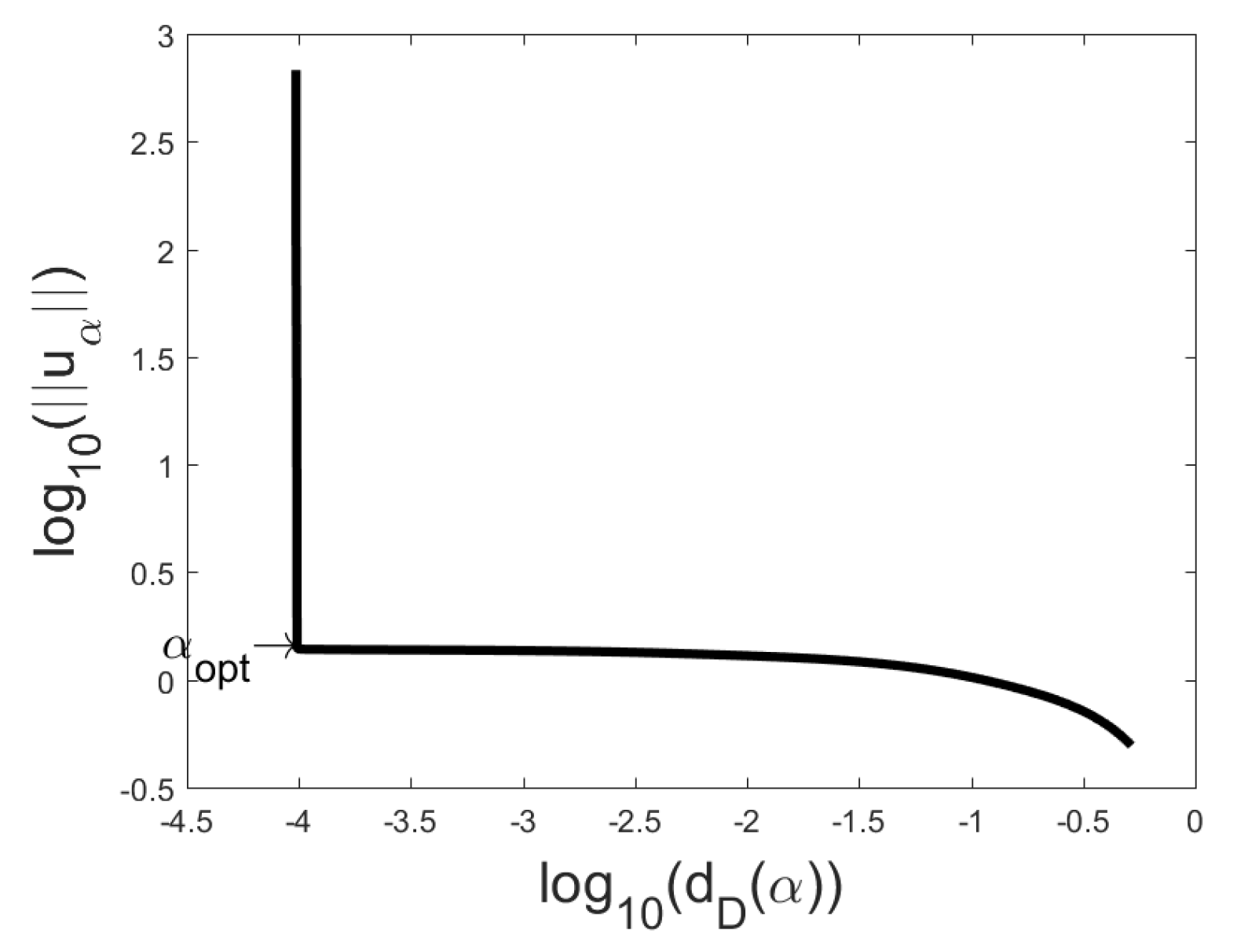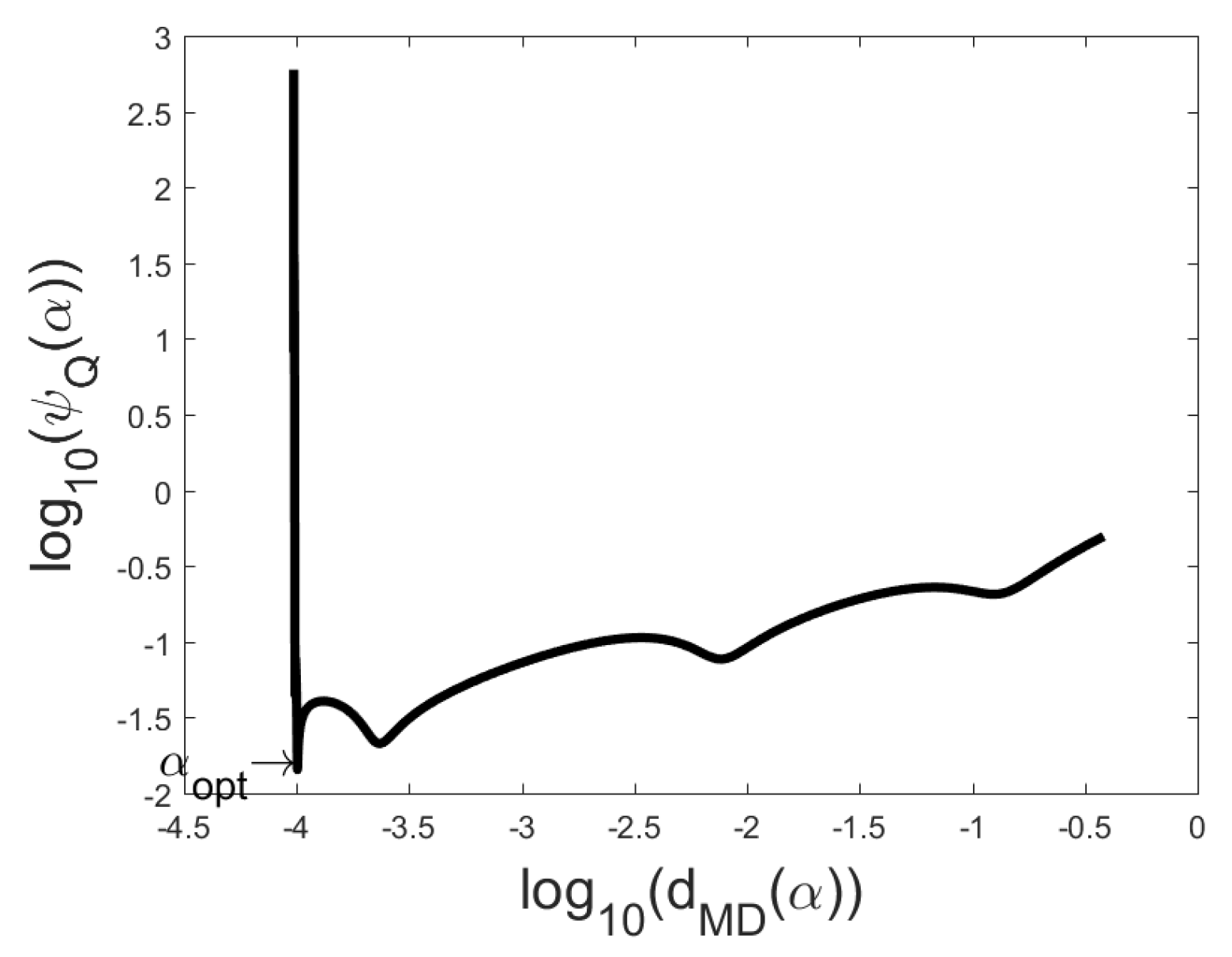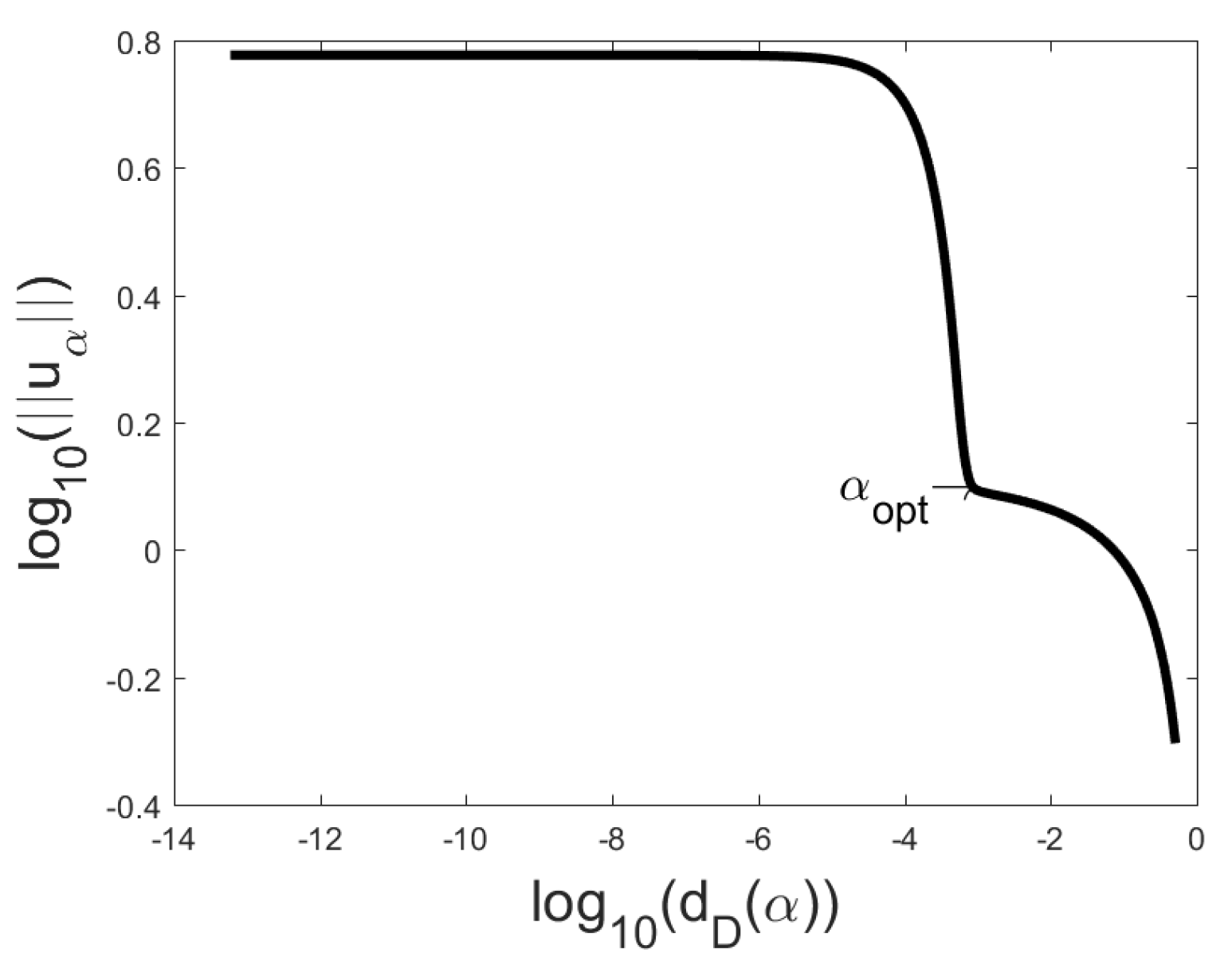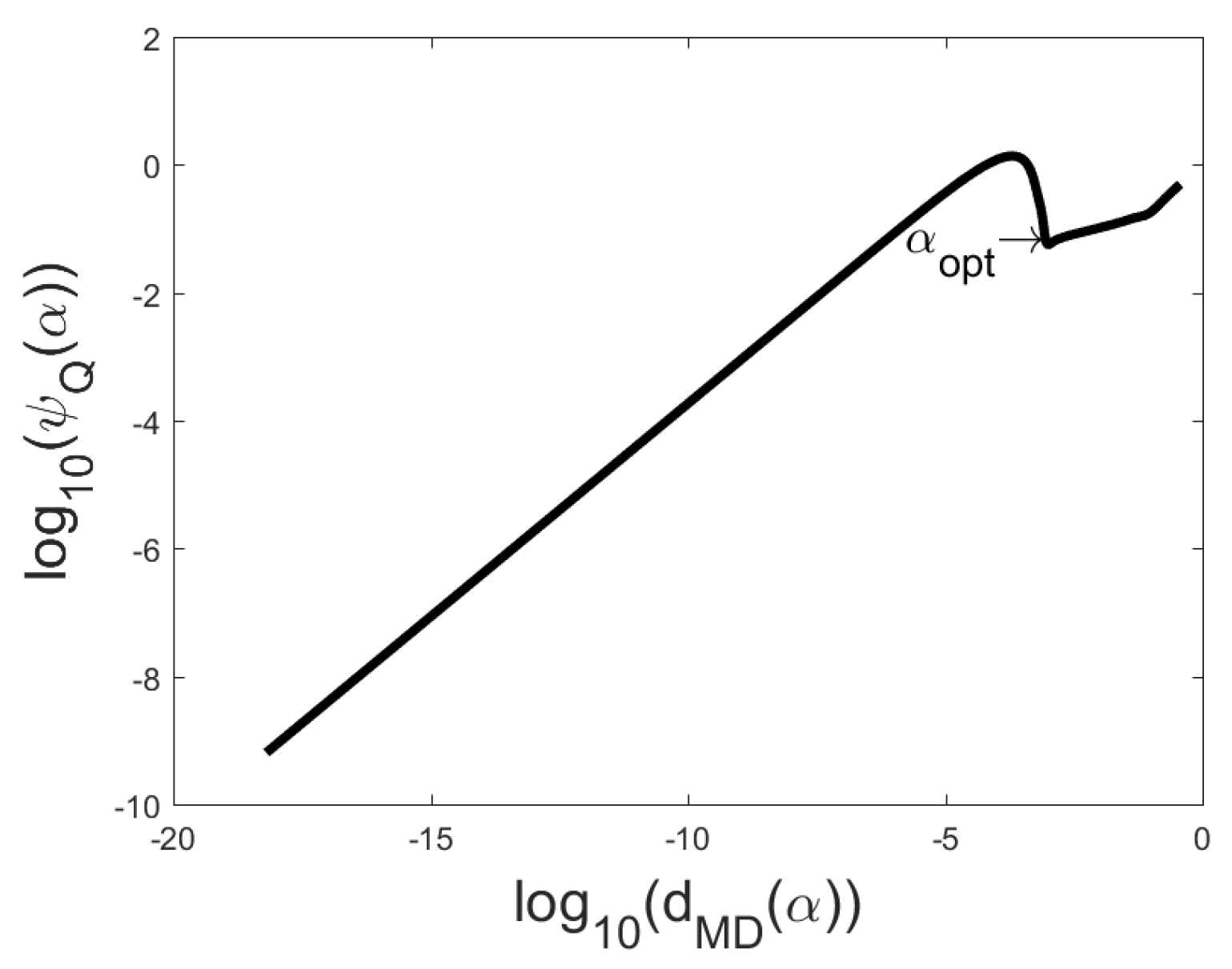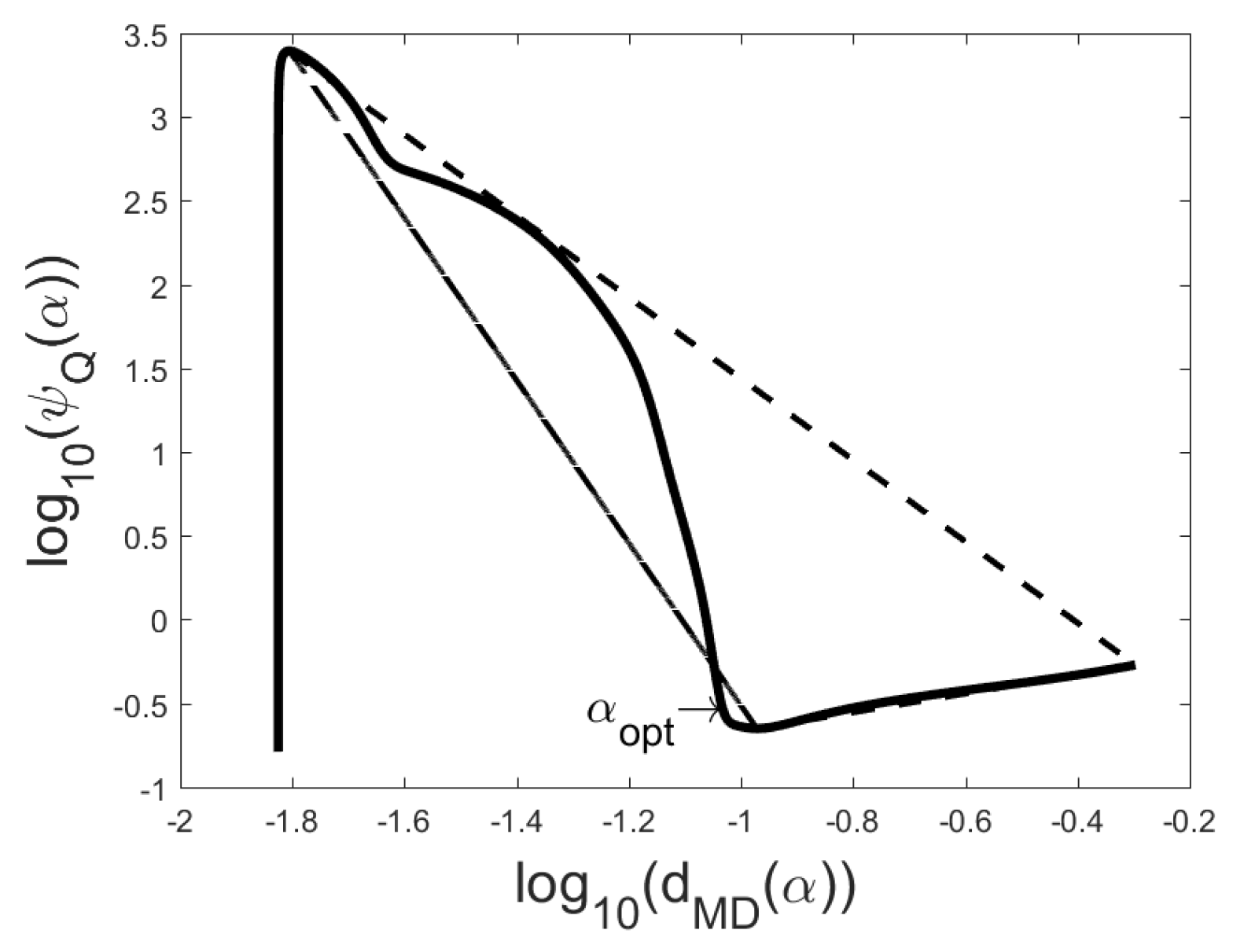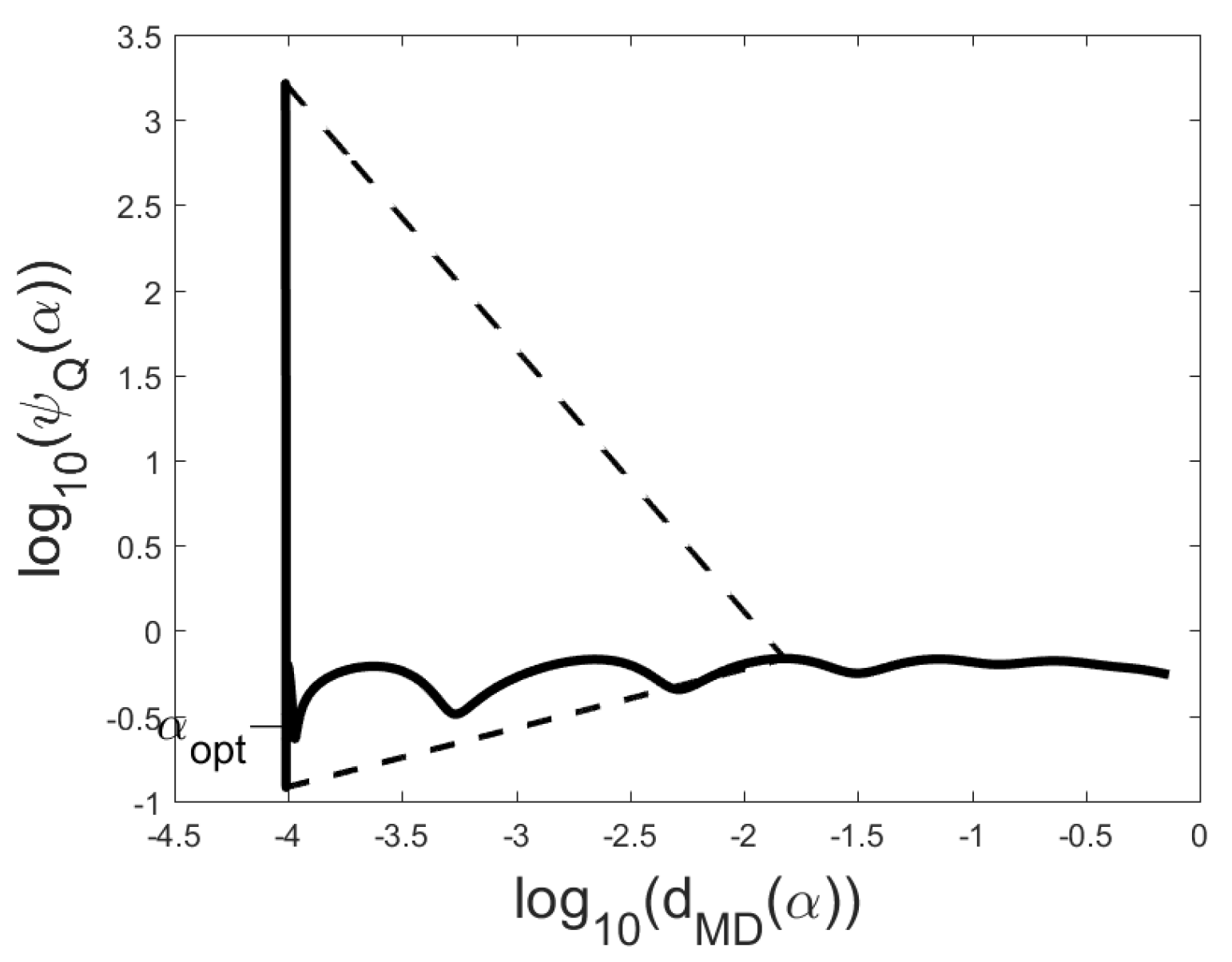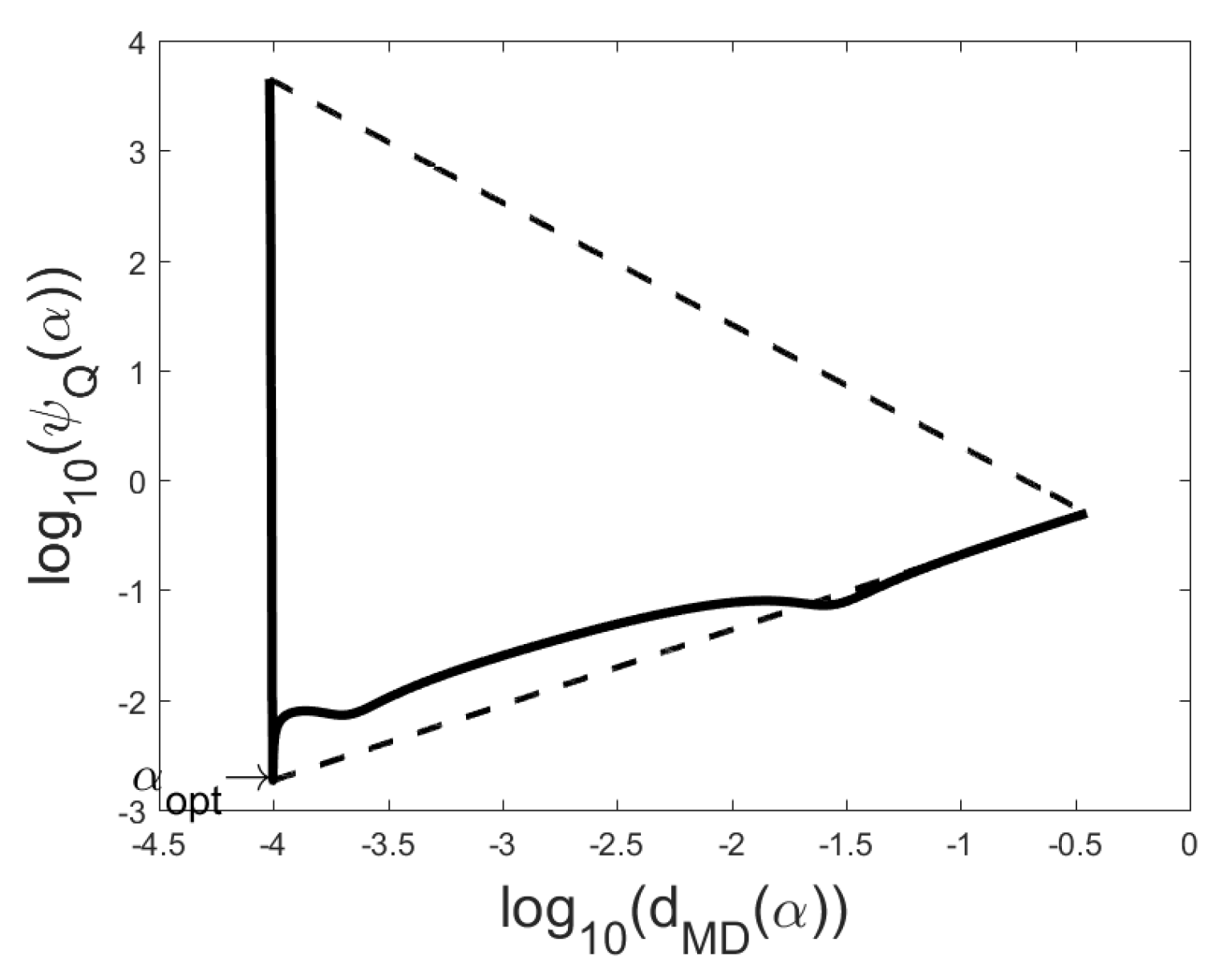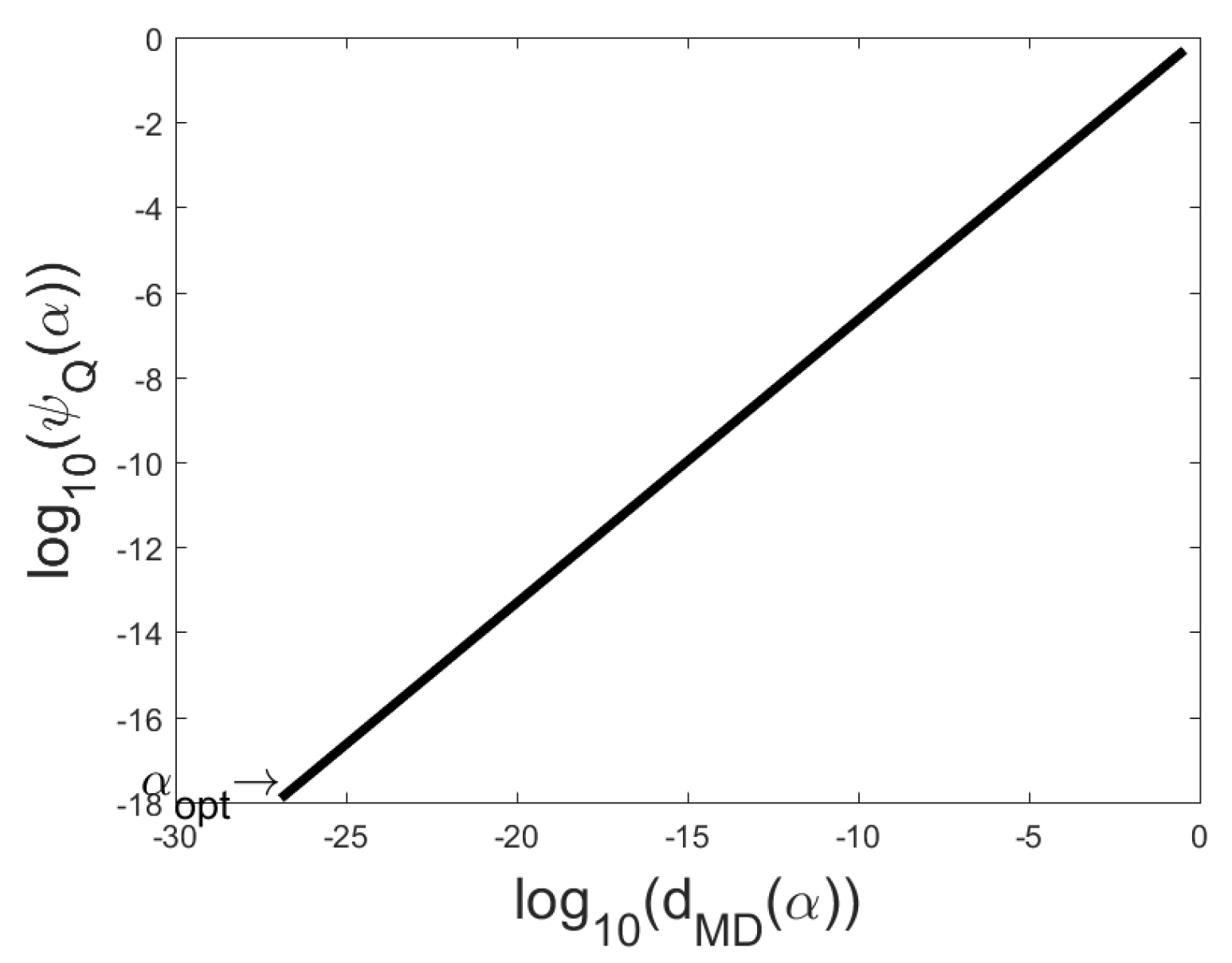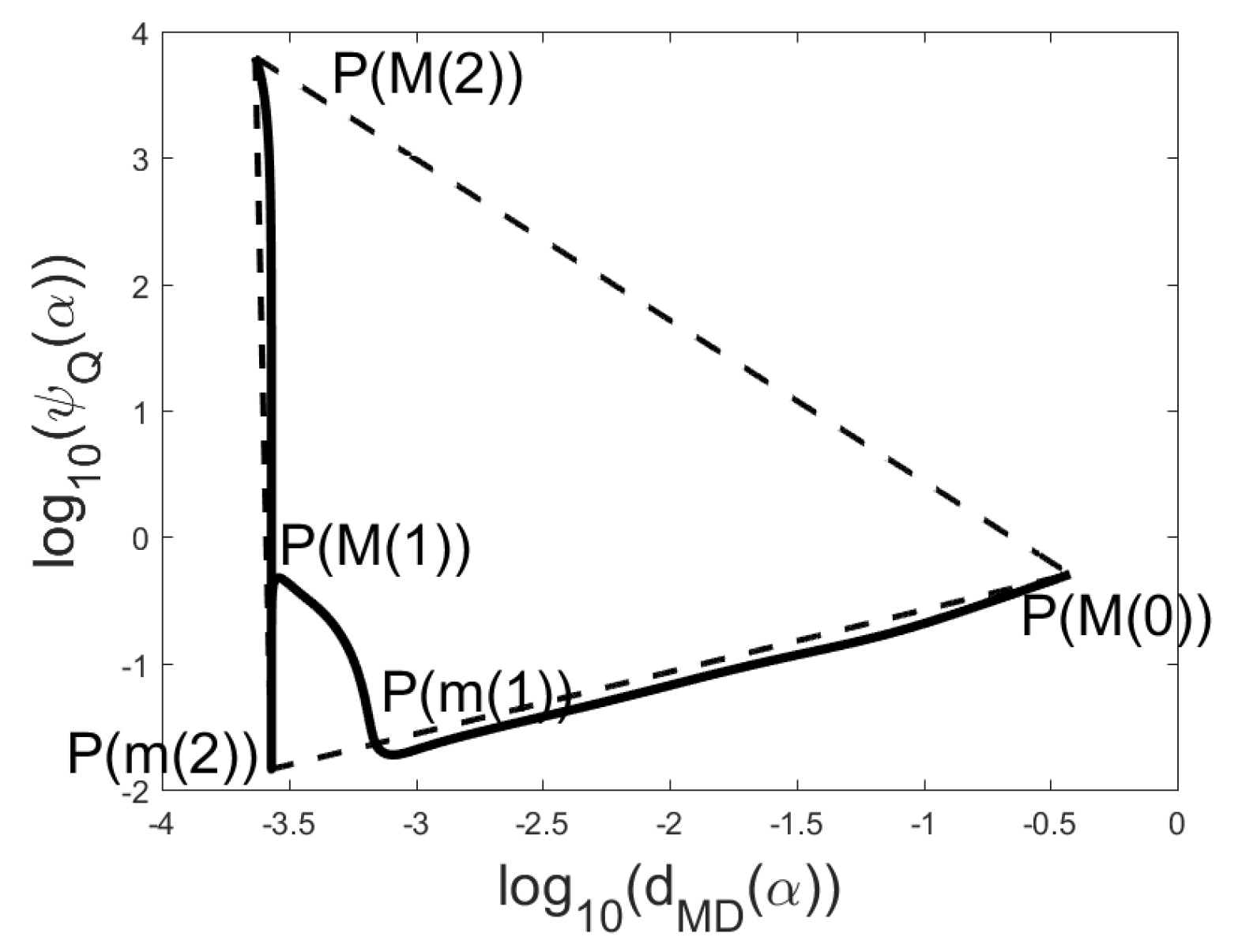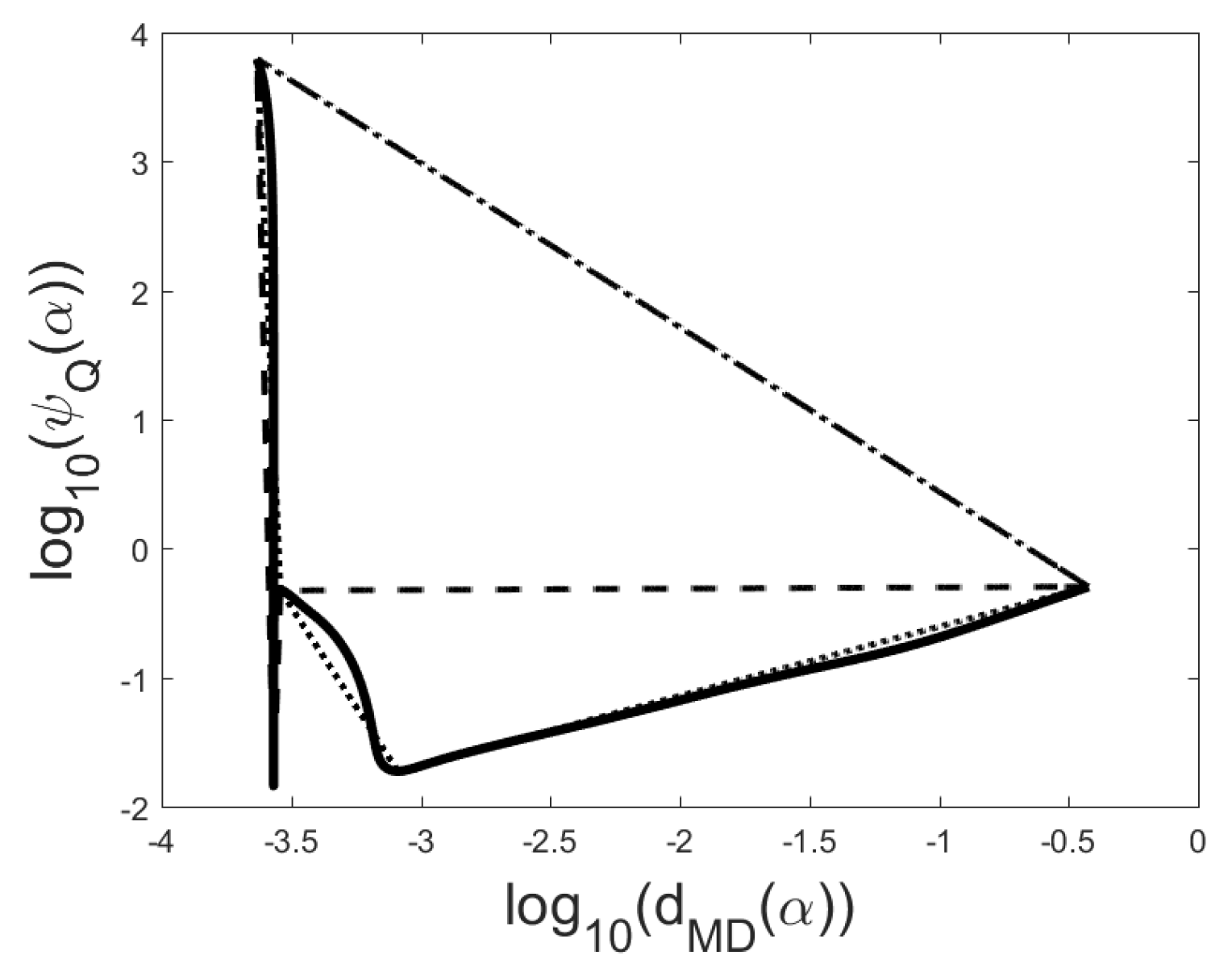1. Introduction
Let
be a linear bounded operator between real Hilbert spaces
H,
F. We are interested in finding the minimum norm solution
of the equation
where noisy data
are given instead of the exact data
. The range
may be non-closed and the kernel
may be non-trivial, so in general this problem is ill-posed. We consider the solution of the problem
by the Tikhonov method (see [
1,
2]) where the regularized solutions in cases of exact and inexact data have the corresponding forms
and
is the regularization parameter. Using the well-known estimate
(see [
1,
2]) and notations
we have the error estimates
We consider choice of the regularization parameter if the noise level for
is unknown. The parameter choice rules which do not use the noise level information are called heuristic rules. Well known heuristic rules are the quasi-optimality criterion [
3,
4,
5,
6,
7,
8,
9], L-curve rule [
10,
11], GCV (generalized cross-validation)-rule [
12], Hanke–Raus rule [
13], Reginska’s rule [
14] and its modifications [
15]; for other rules see [
16,
17,
18]. Heuristic rules are numerically compared in [
4,
17,
18,
19]. The heuristic rules give good results in many problems, but it is not possible to construct heuristic rules guaranteeing convergence
as the noise level goes to zero (see [
20]). All heuristic rules may fail in some problems and without additional information about the solution, it is difficult to decide, is the obtained parameter reliable or not.
In the quasi-optimality criterion the parameter is chosen as the global minimizer of the function on certain interval. We propose to choose the parameter from the set of local minimizers of this function from certain set of parameters.
We will call the parameter
in arbitrary rule R as pseudooptimal, if
with relatively small constant
c and we show that at least one parameter from set
has this property. For the choice of proper parameter from the set
some algorithms were proposed in [
21], in the current work we propose other algorithms. We propose to construct the Q-curve which is the analogue of the L-curve [
10], but on the
x-axis we use modified discrepancy instead of discrepancy and on the
y-axis function
instead of
For finding proper local minimizer of the function
, we propose the area rules on the Q-curve. The idea of proposed rules is that we form, for every minimizer of the function
, a certain function which approximates the error of the approximate solution and has one minimizer; we choose for the regularization parameter such local minimizer of
, for which the area of the polygon, connecting this minimum point with certain maximum points, is maximal.
The plan of this paper is as follows. In
Section 2 we consider known rules for choice of the regularization parameter, both in case of known and unknown noise level. In
Section 3, we prove that the set
contains at least one pseudooptimal parameter. In
Section 4, information about used test problems (mainly from [
11,
22], but also from [
11,
23,
24,
25,
26]) and numerical experiments is given. In
Section 5, we consider the Q-curve and area rule, in
Section 6 further developments of the area rule. These algorithms are also illustrated by the results of numerical experiments.
4. On Test Problems and Numerical Experiments
We made numerical experiments for the local minimizers of the function
using three sets of test problems. The first set contains 10 well-known test problems from Regularization Toolbox [
11] and the following 6 Fredholm integral equations of the first kind (discretized by the midpoint quadrature formula)
Groetsch1 [
24]:
,
,
Groetsch2 [
24]:
,
,
Indram [
25]:
,
,
,
Ursell [
11]:
,
,
,
Waswaz [
26]:
,
,
Baker [
23]:
,
,
,
The second set of test problems are well-known problems from [
22]: Gauss, Hilbert, Lotkin, Moler, Pascal, Prolate. As in [
22], we combined these six
matrices with 6 solution vectors
,
,
,
,
if
and
if
. For getting the third set of test problems we combined the matrices of the first set of test problems with 6 solutions of the second set of test problems.
Numerical experiments showed that performance of different rules depends essentially on eigenvalues of the matrix
. We characterize these eigenvalues via three indicators: the value of minimal eigenvalue
, by the value
, showing the number of eigenvalues less than
and by the value
, characterizing the density of location of eigenvalues on the interval
. More precisely, let the eigenvalues of the matrix
be
. Then the value of
is found by the formula
. We characterize the smoothness of the solution by the value
where
.
Table 1 contains the results of characteristics of the matrix
in case
In all tests the discretization parameters
were used. We present the results of numerical experiments in tables for
. Since the performance of rules generally depends on the smoothness
p of the exact solution in (
1), we complemented the standard solutions
of (now discrete) test problems with smoothened solutions
computing the right-hand side as
. Results for
are given in
Table 2, in all other tables and figures
. After discretization, all problems were scaled (normalized) in such a way that the norms of the operator and the right-hand side were 1. All norms here and in the text below are Euclidean norms. On the base of exact data
we formed the noisy data
f, where
has values
, noise
has normal distribution and the components of the noise were uncorrelated. We generated 20 noise vectors and used these vectors in all problems. We search the regularization parameter from the set
, where
and
N is chosen so that
. To guarantee that calculation errors do not influence essentially the numerical results, calculations were performed on geometrical sequence of decreasing
-s and finished for largest
with
, while theoretically the function
is monotonically increasing. Actually this precautionary measure was needed only in problem Groetsch2, calculations on
were finished only in this problem. Since in model equations the exact solution is known, it is possible to find the regularization parameter
, which gives the smallest error on the set
. For every rule R the error ratio
describes the performance of the rule R on this particular problem. To compare the rules or to present their properties, the following tables show averages and maximums of these error ratios over various parameters of the data set (problems, noise levels
). We say that the heuristic rule fails if the error ratio
. In addition to the error ratio
E we present in some cases also error ratios
The results of numerical experiments for local minimizers
of the function
are given in
Table 3. For comparison, the results of
-rules with
are presented in the columns 2–4. Columns 5 and 6 contain respectively the averages and maximums of error ratios
E for the best local minimizer
. The results show that for many problems the Tikhonov approximation with the best local minimizer
is even more accurate than with the
-rules parameters
or
.
Table 1 and
Table 3 show also that for rules ME and MEe the average error ratio
E may be relatively large for problems where
is large and most of eigenvalues are smaller than
, while in this case
may be essentially smaller than
. In these problems the discrepancy principle gives better parameter than ME and MEe rules. The average error in ME rule was largest in the problem Waswaz2, but error ratio E2 there is still under 1. This is due to the fact that for the tasks where the size of a
(defined on previous page) is large, the minimal error may be significantly smaller than
.
Columns 7 and 8 contain the averages and maximums of cardinalities
of sets
(number of elements of these sets). Note that the number of local minimizers depends on the parameter
q (for smaller
q the number of local minimizers is smaller) and on the length of minimization interval determined by the parameters
,
. The number of local minimizers is smaller also for larger noise level. Columns 9 and 10 contain the averages and maximums of values of constant
C in the a posteriori error estimate (
11). The value of
C and error estimate (
11) allow to assert, that in our test problems the choice of
as the best local minimizer in
guarantees that the error of the Tikhonov approximation has the same order as
. Note that over all test problems the maximum of error ratio
for the best local minimizer in
and for the discrepancy principle were 1.93 and 9.90, respectively. This confirms the result of Theorem 3 that at least one minimizer of the function
is a good regularization parameter.
5. Q-Curve and Triangle Area Rule for Choosing Heuristic Regularization Parameter
We showed in the previous section that at least one local minimizer of the function
is pseudooptimal parameter and we may omit small local minimizers
, for which
is only slightly larger than
. We propose to construct for the parameter choice the Q-curve. The Q-curve figure uses the log-log scale with functions
and
on the
x-axis and
y-axis, respectively. The Q-curve can be considered as the analogue of the L-curve, where functions
and
are replaced by functions
and
(see (
4)), respectively. We denote
. For many problems the curve
(or a part of this) has the form of letter L or V and we choose the minimizer at the “corner” point of L or V. We use the common logarithm instead of the natural logarithm, while then the Q-curve allows easier estimation of the supposed value of the noise level. In
Figure 1,
Figure 2,
Figure 3,
Figure 4,
Figure 5,
Figure 6,
Figure 7 and
Figure 8 is used, in
Figure 9 and
Figure 10 . In
Figure 1,
Figure 2,
Figure 3 and
Figure 4 the L-curves and Q-curves are compared for two problems, the global minimizer
of the function
is also presented. Note that in problem Baart
and in problem Deriv2
.
In most cases one can see on the Q-curve only one clear corner area with one local minimizer and then we take this local minimizer as corner point. If the corner area contains several local minimizers, we recommend to choose such local minimizer, for which the sum of coordinates of the corresponding point on the Q-curve is minimal. If Q-curve has several corner areas we recommend to use the very right of them. Actually, it is useful to present in the parameter choice besides the figures for every local minimizer of the function also the coordinates of the point and the sums of the coordinates.
For finding the proper local minimizer of the function
we present now a rule which works well for all test problems from set 1. The idea of the rule is to search the proper local minimizer
constructing certain triangles on the Q-curve and finding which of them has the maximal area. For every parameter
corresponds a point
on the Q-curve with the corresponding coordinates
. For every local minimizer
of the function
corresponds a triangle
with the vertices
and
on the Q-curve, where indices
and
correspond to the largest local maximums of the function
on two sides of the local minimum
:
Triangle area rule (TA-rule). We choose for the regularization parameter such local minimizer of the function for which the area of the triangle is the largest.
Figure 5,
Figure 6 and
Figure 7 show examples of Q-curves and the triangle
with the largest area, the TA-rule chooses for the regularization parameter a corresponding minimizer. In some problems the function
may be monotonically increasing as for the problem Groetsch2 (
Figure 8), then function
has only one local minimizer
. Then vertices
and
coincide and the area of the corresponding triangle is zero. Then this is the only triangle, the TA-rule chooses for the regularization parameter
. The results of the numerical experiments for test set 1 (
) for the TA-rule and some other rules (see
Section 2.2) are given in
Table 4 and
Table 5. These results show that the TA-rule works well in all these test problems, the accuracy is comparable with
-rules (see
Table 3), but previous heuristic rules fail in some problems. Note that average of the error ratio increases for decreasing noise level. For example, for
corresponding error ratios
E were 1.47, 1.49, 1.78 and 2.08 respectively.
Let us comment on other heuristic rules. The accuracy of the quasi-optimality criterion is for many problems the same as for the TA-rule, but this rule fails in problem Heat. A characteristic feature of the problem Heat is that location of the eigenvalues in the interval
is sparse and only some eigenvalues are smaller than
(see
Table 1). The weighted quasioptimality criterion behaves in a similar way as the quasioptimality criterion, but is more accurate in problems where
; if
, the quasioptimality criterion is more accurate. The rule of Hanke–Raus may fail in test problems with large
and for other problems the error of the approximate solution is in most problems approximately two times larger than for parameter chosen by the quasi-optimality principle. The problem in this rule is that it chooses too large parameter compared with the optimal parameter. However, HR-rule is stable in the sense that the largest error ratio E2 is relatively small in all considered test problems. Reginska’s rule may fail in many problems but it has the advantage that it works better than other previous rules if the noise level is large. The Reginska’s rule did not fail in case
and has average of error ratios of all problems
and
in cases
and
, respectively. Advantage of the maximum curvature rule is the small percentage of failures compared with other previous rules.
Distribution of error ratios E in
Table 5 show also that in test problems set 1 the TA-rule is the most accurate rule from all considered rules.
Note that the figure of the Q-curve enables to estimate the reliability of the chosen parameter. If the Q-curve has only one corner, then the chosen parameter is quasioptimal with small constant C, if , but in case it is quasioptimal under assumption that the problem needs regularization.
6. Further Developments of the Area Rule
The TA-rule may fail for problems which do not need regularization, if function
is not monotonically increasing. In this case, the TA rule selects the parameter
, but the parameter
would be better. For example, the TA-rule fails for matrix
Moler in some cases. Let us consider now the question, in which cases the regularization parameter
is good. If function
is monotonically increasing then function
has only one local minimizer
and then for the parameter
we have the error estimate
where the value of
(see Theorem 3) can be computed a posteriori and this value is the smaller the faster the function
increases. We can take
for the regularization parameter also in the case if the condition
holds while one can show similarly to the proof of Theorem 3 that
and the error of the regularized solution is small. For the problems which do not need regularization we can improve the performance of the TA-rule searching the proper local minimizer smaller or equal than
where
,
are the global minimizers of functions
and
, respectively on the interval
.
These ideas enable to formulate the following upgraded version of the TA-rule.
Triangle area rule 2 (TA-2-rule). We fix a constant
. If condition (
20) holds, we choose the parameter
. Otherwise choose for the regularization parameter such local minimizer
of the function
for which the area of triangle
is largest.
Results of numerical experiments for the rule TA-2 with the discretization parameter
and problem sets 1–3 are given in
Table 6 and
Table 7 (columns 2 and 3). The results show that the rule TA-2 works well in all considered testsets 1–3. However, the rule TA-2 may fail in some other problems which do not need regularization. Such example is the problem with matrix
moler and solution
, where the rule TA-2 fails if the noise level is below
; but in this case all other considered heuristic rules fail too.
The rules TA and TA-2 fail in problem Heat in some cases for the discretization parameter
.
Figure 9 and
Figure 10 show the form of the Q-curve in problem Heat with
. The function
has two local minimizers with corresponding points
and
on the Q-curve and 3 local maximum points
. On
Figure 9 the Rule TA-2 chooses the local minimizer corresponding to the point
, but then the error ratios are large:
.
In the following we consider methods which work well also in this problem. Let
be the parametric representation of the straight line segment connecting points
ja
, thus
Let
,
be the parametric representation of the broken line connecting points
,
, thus
In the triangle rule certain points
are connected by the broken line
which approximates the error function
well, if
is the “right” local minimizer. By construction of the function
we use only 3 points on the Q-curve. We will get a more stable rule if the form of the Q-curve has more influence to the construction of approximates to the error function
. Let
and
be the largest sets of the indices, satisfying the inequalities
It is easy to see that and . For approximating the error function we propose to connect points by the broken line and to find for every the area of the polygon surrounded by the lines and . The second possibility is to approximate the error function by the curve and to find as the area of the polygon surrounded by the broken lines and curve . Note that functions are monotonically increasing if , and monotonically decreasing if .
Area rules 2 and 3. We fix a constant
. First we choose the local minimizer
, for which the area
is largest. We take for the regularization parameter the smallest
, satisfying condition (compare with (
20))
Let us consider
Figure 9. The reason for the failure of the triangle rule is, that for the local minimizer
the broken line
do not approximate well the function
, while point
is located above the interval
. Here the function
is better approximated by the broken line
, see
Figure 10. For the local minimizer
, we approximate function
by the broken line
and due to the inequality
the area rule 2 chooses
for the regularization parameter, then
.
The area rules 2 and 3 work in problem Heat well for every
n and all
, but in some other problems the accuracy of the area rules 2 and 3 (see columns 4–7 of
Table 6 and
Table 7) is slightly worse than for the rule TA-2. The advantage of the area rule 3, as compared to the area rule 2, is to be highlighted in problem Heat if all noise of the right hand side is placed on one eigenelement (then we use the condition
only in case
). Then the area rule 3 did not fail if
and
. So we can say, the more precisely we take into account the form of the Q-curve in construction of the approximating function for the error function
, the more stable is the rule.
Based on the above rules it is possible to formulate a combined rule, which chooses the parameter according to the rule TA-2 or area rule 3 in dependence of certain condition.
Area rule 4 (Combined area rule). Fix a constant
. Let the local minimizer
be chosen by the rule TA-2. If
we take
for the regularization parameter, otherwise we choose the regularization parameter by the area rule 3.
Note that the combined rule coincides with the rule TA-2, if
and with the area rule 3, if
. Experiments of combined rule with
(columns 8 and 9 in
Table 6 and
Table 7) show that the accuracy of this rule is almost the same as in the triangle rule, but unlike the TA-2 rule, it works well also in problem Heat for all
n and
. Although, in some cases, in test set 3 the error ratio
for rule 4, the high qualification of the rule is characterized by the fact, that over all problems sets 1–3 the largest error ratio E1 was 16.91 (5.06 for set 1) and the largest error ratio E2 was 4.67 (2.62 for set 1). Numerical experiments show that it is reasonable to use parameter
. We studied the behavior of the area rules for different
. The results were similar to the results of
Table 6 and
Table 7, but for smaller
the error ratios were 2–3% smaller than for
and for larger
the error ratios were about 5% larger than in
Table 6 and
Table 7.
The
Table 2 gives results of the numerical experiments in the case of smooth solution,
. We see that combined rule worked well also in this case, no failure.
Remark 5. It is possible to modify the Q-curve. We may use the function instead of function and find proper local minimizer of the function . Unlike the quasi-optimality criterion the use of function in the Q-curve and in the area rule does not increase the amount of calculations, while approximation is needed also in computation of . We can use in these rules the function instead of , it increases the accuracy in some problems, but the average accuracy of the rules is almost the same. In case of nonsmooth solutions we can modify the Q-curve method and area rule, using the function instead of . In this case, we get even better results for but for , the error ratio E is on average 2 times higher.
Note that if the solution is smooth, then L-curve rule and Reginska’s rule often fail, but replacing in these rules the function by the function gives often better results.
Remark 6. If the solution is smooth, then using α-s from (8) much better approximate solution than single Tikhonov approximation may be get using the linear combinations of Tikhonov approximations, see [40]. In the case of a heuristic parameter choice, it is also possible to use the a posteriori estimates of the approximate solution, which, in many tasks, allows to confirm the reliability of the parameter choice. Let
be the regularization parameter from some heuristic rule and
be the local minimizer of the function
on the set
. Then in the case
the error estimate
holds where
. Using the last estimate, we can prove similarly to the Theorem 7 that if
is so small that
, then
where
. If values
and
b, what we find a posteriori, are small (for example
and
), then this estimate allows to argue that the error of the approximate solution for this parameter is not much larger than the minimal error. The conditions
,
were satisfied in set 1 of test problems in the combined rule for 73% of cases and inequalities
,
for 61% of cases. The reason of failure of heuristic rule is typically that the chosen parameter is too small. To check this, we can use the error estimate (
21). If
is relatively small (for example
), then the estimate (
21) allows to argue that the regularization parameter is not chosen too small. In set 1 of test problems the conditions
and
were satisfied in 97% and in 82% of cases, respectively.
